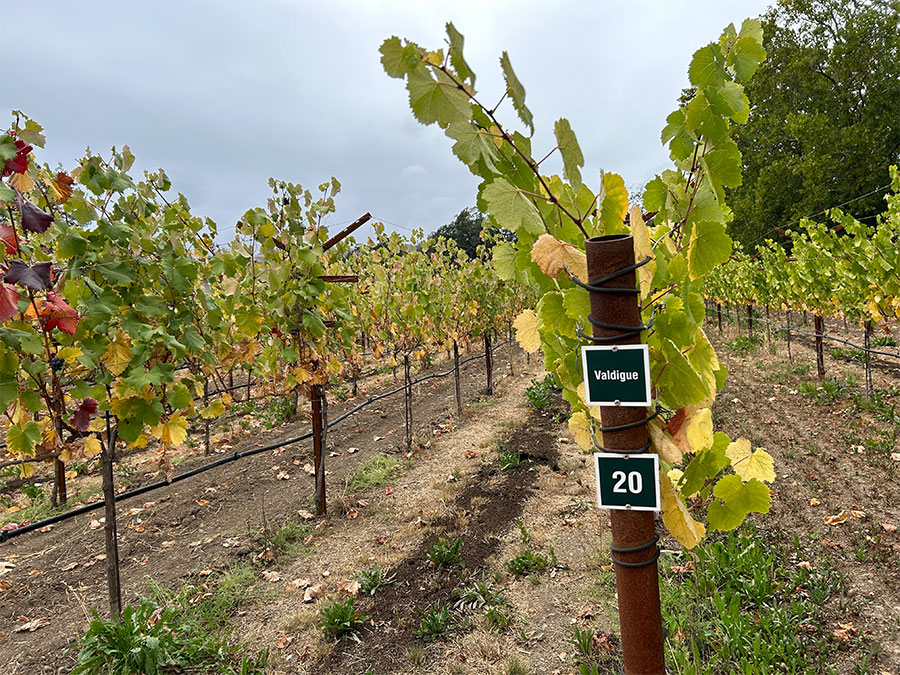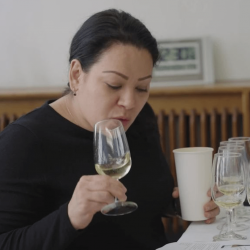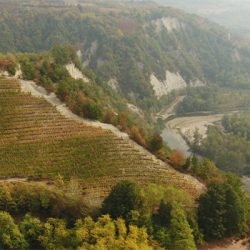

Spottswoode’s Old Spring Creek Vineyard is planted to just over two acres of petite sirah a few blocks south of the winery in St. Helena. In 2019, when it finally succumbed to virus and needed replanting, winegrower Aron Weinkauf went to his bosses and said, “How cool would it be if we dedicated some of this to R & D?”
To such notions, he has very receptive bosses. Yes, the Napa Valley and much of California were still recovering from two devastating fire seasons, a signal to many of the extremes to come from climate change. As for the Novak family at Spottswoode, they had been among the most ecologically minded in the Napa Valley for decades. They had been farming organically since 1985, and certified since 1992, and have long been in the forefront of climate action in the region. Still, planting decisions like these aren’t made lightly in a valley where an acre of land can go for hundreds of thousands of dollars and require a requisite return, in the form of expensive bottlings, usually with cabernet sauvignon in the mix, a variety that has long commanded high prices. But the family took him up on the challenge.
Weinkauf set about looking for varieties that would address some of the issues he believed the extremes of climate change demanded. He needed workhorses, varieties that could keep their color, and show some durability with thick skins; he considered vines noted for their drought and heat tolerance. In the end, he planted his R&D parcel to alicante bouschet, touriga nacional, tinta cão, souzão, carignane, mourvedre, manseng noir, marselan, arinarnoa, petite sirah and valdiguié, as well as two whites, falanghina and assyrtiko. In 2021, when Bordeaux sanctioned seven new varieties of their own to address global warming, Weinkauf felt a bit of satisfaction. “There was plenty of overlap with my selections,” he said. “It was affirming, for sure.”
Weinkauf’s informal partner-in-crime in these ventures has been his friend Dan Petroski, who was, until 2021, winemaker at Larkmead, a Calistoga winery with one of Napa Valley’s warmest mesoclimates. The property has seen huge spikes in degree days in the last decade. After lengthy discussions with Weinkauf, Petroski pulled the trigger on three acres of alternate varieties one year later in 2020.
They’re not the only ones replanting toward the future. Across the North Coast, Hudson Vineyards, Jackson Family Farms, the Crimson Wine Group, E. & J. Gallo and others have started to throw spaghetti strands at the wall. Spottswoode and Larkmead now have something to show for it, in nascent bottlings that may provide a glimpse into Napa Valley’s next epoch, an era of climate extremes. At least hypothetically, both winemakers have started to wonder not whether cabernet’s days in the valley are numbered, but rather what should replace it, should it come to the end of its useful life.


“This became a cab valley in the seventies. There are, and there were, so many varieties that have thrived here.” —Spottswoode Winegrower Aron Weinkauf
Weinkauf likes to point out that, historically, at least, the valley has never been the exclusive terrain of cabernet sauvignon. “This became a cab valley in the seventies,” he says. “There are, and there were, so many varieties that have thrived here.”
Petroski agrees that Napa Valley is not necessarily predisposed to cabernet, and worries that the variety may suffer in the years to come. “Global warming will inevitably put pressure on the qualities we love about cabernet,” he says. “The fruit, the richness, the power, the structure, the balance, the elegance—all of those things will be under stress.”
Meanwhile, he believes that Napa Valley remains an ideal terroir for sturdier red varieties. His plantings included eight reds that, he hoped, could adapt to whatever Napa Valley’s climate extremes could throw at them. In his selections, he looked to the greats for guidance: He planted tempranillo with Vega-Sicilia as a model; aglianico with an eye to the Taurasi reds of Mastroberardino; and touriga nacional with Casa Ferreirinha Barca Velha as his benchmark. “We can do all this here, and better than in most places,” he insists. “It doesn’t need to be cabernet.”
Many growers feel that calling out cabernet is premature, insisting that there is no better variety to face such challenges and extremes. “Cabernet sauvignon may be the most heat-adaptive variety we could be planting,” says Steve Matthiasson, of Matthiasson Wines, whose main gig is Premiere Viticulture Services, his consultancy in partnership with Garrett Buckland, working with vineyards all over the valley. When it comes to cabernet sauvignon, Matthiasson believes, “It’s resilient, it has good vigor, it can shade itself, and has a long ripening period, with thick skins and tough berries that can handle the heat.”
He adds, “The Napa Valley is an extremely diverse place—not just soils, but climate. Carneros has two-thirds the heat accumulation as Calistoga, and Carneros is still thought of as too cool for cabernet; so is Oak Knoll.” Matthiasson finds there are still parts of the valley that aren’t ready for cabernet, which means that the area as a whole is likely to be viable for a lot longer—rendering this discussion premature at best. “If you’re Larkmead, it’s a different situation than if you’re Sinskey,” he says.


Since Petroski left Larkmead to concentrate on his own label, Massican, Avery Heelan has taken over winemaking duties, including the alternative varieties project; she plans to take it forward as Petroski had envisioned. “Our owners just celebrated their 75th anniversary,” says Heelan. “That’s partly why sustainability arguments are an easy sell with this family. If what we’re doing allows us to make better wine, it’s worthwhile. The finance guys might disagree, but we want to plan for the next 75 years, too.”
In 2023, Heelan was able to harvest enough grapes to make wine. “I think it might have been the wrong season to assess them,” she admits. “These varieties were planted for bad conditions, and the vintage has been too perfect.” Early fermentation trials are promising, but she insists, it’s not time yet to jump to any conclusions. “We’re still looking for clues as to which of these makes the best wines, as individual as possible.”
Weinkauf is taking a different approach to his experimental plot at Spottswoode. The winery is planning to release a bottling in the coming years and, at least for now, it’s a field blend. Not only does Weinkauf love field blends, he loves Napa Valley’s history with them, and hopes this might contribute to that tradition. The 2023, still in tank, its fermentation incomplete, is wiry and rustic, full of untamed energy. The 2022, made with a co-fermentation of all of the red varieties, is considerably more composed, with streaks of blue fruit. It’s polished in spots, patchy in others, still showing some of that fidgety and untamed character apparent in the 2023.
Neither wine is in its finished state, nor is the discussion of what the future holds for Napa Valley’s vinelands. The valley’s growers are unlikely to abandon cabernet sauvignon. But when it comes to experimental varieties, whether presented on their own or as field blends, there will be more action in the years to come.
Patrick J. Comiskey covers US wines for Wine & Spirits magazine, focusing on the Pacific Northwest, California’s Central Coast and New York’s Finger Lakes.
This story appears in the print issue of Winter 2023.
Like what you read? Subscribe today.


















